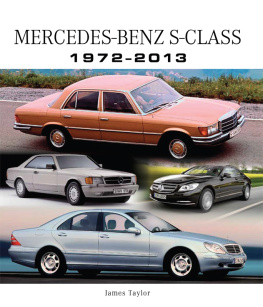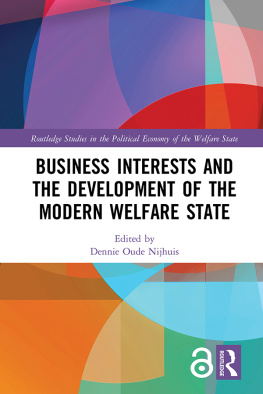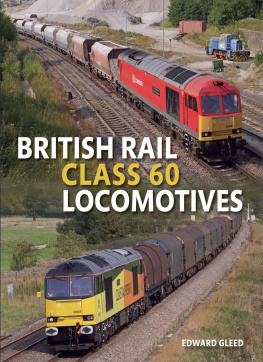First published in 2013 by
The Crowood Press Ltd
Ramsbury, Marlborough
Wiltshire SN8 2HR
www.crowood.com
This e-book first published in 2014
James Taylor 2013
All rights reserved. No part of this publication may be reproduced or transmitted in any form or by any means, electronic or mechanical, including photocopy, recording, or any information storage and retrieval system, without permission in writing from the publishers.
British Library Cataloguing-in-Publication Data
A catalogue record for this book is available from the British Library.
ISBN 978 1 84797 596 6
CONTENTS
INTRODUCTION AND ACKNOWLEDGEMENTS
It is just over forty years since the Mercedes S-Class was introduced, and I still remember the excitement that was apparent from the first assessment and road-test reports, and my own excitement at seeing one for the first time in a Mercedes showroom in the Swiss resort of Gstaad. The sheer presence of the car, and its undoubted engineering competence, left an impression that has never gone away.
Meanwhile the S-Class itself has gone from strength to strength, and a sixth generation was about to reach the showrooms as this book went to press. All of the first five generations, bar the first itself, were accompanied by coup derivatives which have been equally impressive, rather more exclusive, and in most cases even more desirable than the saloons. Given the chance, I was only too pleased to be able to write about them here, where their story is easy to tell alongside that of the related saloons.
In those forty years, a great deal has been written about the S-Class, most of it in magazines rather than in books. When I came to write this book, I realized just how much of it I must have read, and how much it had already shaped the story of the S-Class cars in my head. So in retrospect, I owe a large debt of gratitude to all those magazines I did read English, American, French, German and even (I think) Italian to foster my interest in the S-Class and to improve my knowledge and understanding of the flagship Mercedes.
I also owe a large debt of gratitude to the Mercedes-Benz Archives, which provided information to fill in a number of gaps in my knowledge, and also a very large proportion of the photographs used in this book. Other pictures have come from other sources and are individually acknowledged, but I have always been deeply impressed by the way Mercedes records its past and makes material available to genuine researchers. So saying, I have no doubt that the way that information is presented to the public can sometimes be slightly skewed in support of a publicity objective, and I hope that this book presents a properly balanced assessment at all times even if it is written by someone who is an acknowledged fan of the S-Class.
James Taylor
Oxfordshire, April 2013
CHAPTER ONE
DEFINING THE S-CLASS
The Mercedes-Benz S-Class has been a massive worldwide success story, one that is the envy of other car manufacturers. The car is almost universally regarded as the pinnacle of automotive excellence the best car in the world, despite Rolls-Royces earlier use of that title and has become a symbol of material success for its owners. It has become a benchmark of good taste in automotive design, and is seen also as a pioneer of new automotive technology of all kinds. Despite determined attempts by rival manufacturers to claim a share of the S-Class market, the car has retained its position at the pinnacle of luxury saloons for more than forty years.
That is a formidable achievement. Not content with building the most widely acknowledged automotive symbol of success, Mercedes has gone on to back it up with exclusive coup derivatives, even more expensive and even more symbolic of material success. The sales of the S-Class have not only had a halo effect on the rest of the Mercedes marque, they have also enabled new technology to be introduced at the top end of the market while the car remains expensive and have then managed to reduce its cost either by further development or simply by volume production, so enhancing the less expensive models in the companys lineup as well. The business model is flawless, and those who have maintained it across five generations of the S-Class with a sixth arriving as this book goes to press deserve the praise that has been heaped upon them from enthusiasts and rivals alike.

This was how Mercedes saw the S-Class lineage in 1980. Far left is a Fintail saloon; next is a W109; and then come the S-Classes proper a green W116 and a yellow W126.
So how did the S-Class come about? When the first version, called W116 by its makers, reached the market in 1972, the Mercedes-Benz marque was making a new assault on international markets. Key among these was North America, where Mercedes models had been widely respected since the early 1950s, but where the company was still very much a bit-part player. New safety and emissions legislation introduced in the USA during the second half of the 1960s had caused enormous problems for domestic makers and importers alike, but Mercedes was determined to hang on in there. So although North American sales were not yet central to the Mercedes business plan, there was every intention of further exploiting what was then the worlds largest car market. US expectations were therefore as important in the thinking behind the original S-Class as were expectations in Africa, the Middle East and Europe.
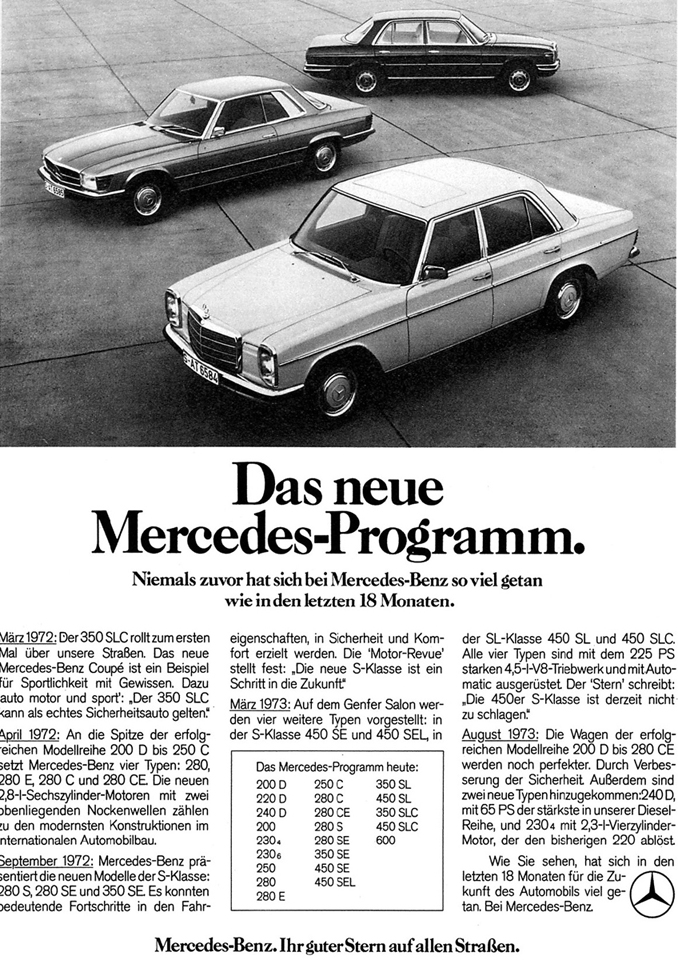
This 1973 advertisement shows the first S-Class, the W116 (at the back of the group) in the context of its contemporaries. In the middle is the flagship SLC coup, derived from the R107 SL roadster, and in front is the latest version of the W114 stroke 8 medium saloons introduced in 1968.
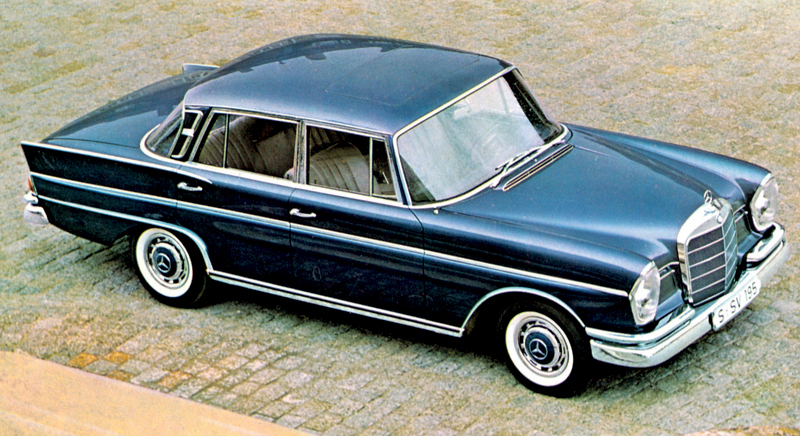
The long-wheelbase 300 SE of 1963 featured air springs, all-round disc brakes and an all-aluminium engine with fuel injection. Though essentially a top model for the Fintail saloon range, it made clear that Mercedes was already thinking about building a better-equipped, luxury model with the latest technical innovations.
Most important, however, was that Mercedes had identified an enduring market for top-quality luxury cars, and intended to exploit it. Perhaps the first clear indication that such a market existed had been the success of the 220 SE coup and cabriolet models introduced in 1961. In the Mercedes scheme of things, they replaced low-volume derivatives of earlier saloon ranges, but they grabbed the attention of a much wider audience. Mercedes would never admit publicly to being surprised by such a thing, but there can be little doubt that these cars helped the company to recognize that there was a readiness for the Mercedes marque among those prepared to spend more than most on their automotive transport.
Within four years Mercedes had a new model range ready to offer such customers. The range consisted entirely of saloons, which would necessarily be less expensive than the prestigious coups and cabriolets, but which moved a step closer to them in their appeal and price. Like the coups and cabriolets, they were actually derivatives of the then-current mid-size saloon platform, rebodied and re-engineered to suggest more prestige. They came with a choice of standard or long (limousine) wheelbases, and with either standard suspension as W108 types, or with advanced air suspension as W109s. They were a cautious first step in the direction of an autonomous prestige saloon range, and during the mid-1960s Mercedes marketing linked them with the coup and cabriolet models to reflect that more upmarket appeal.
Next page
